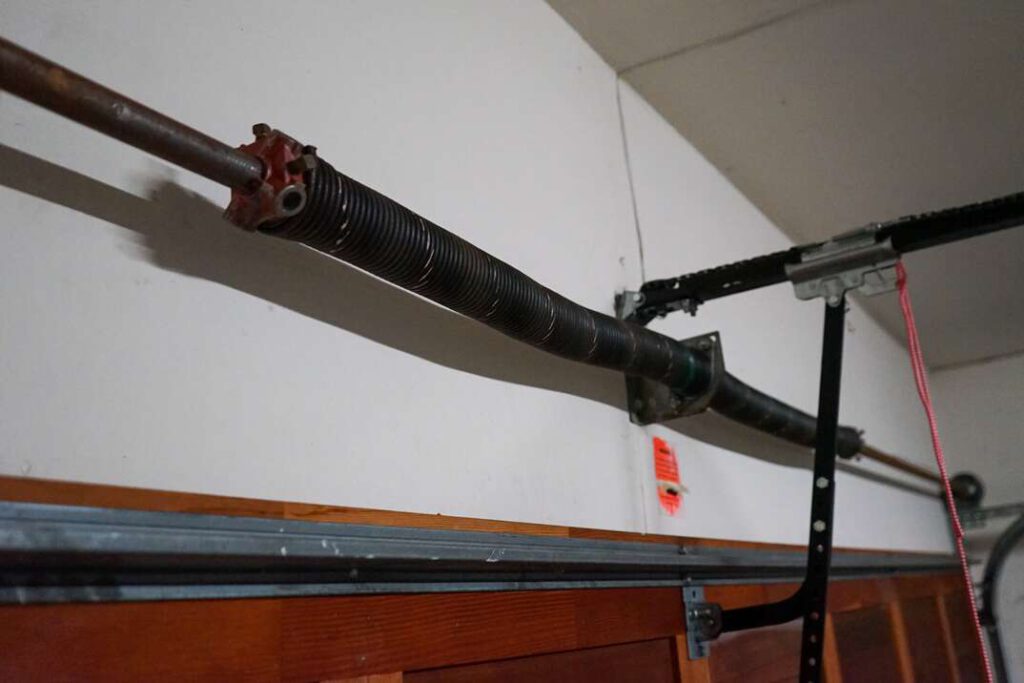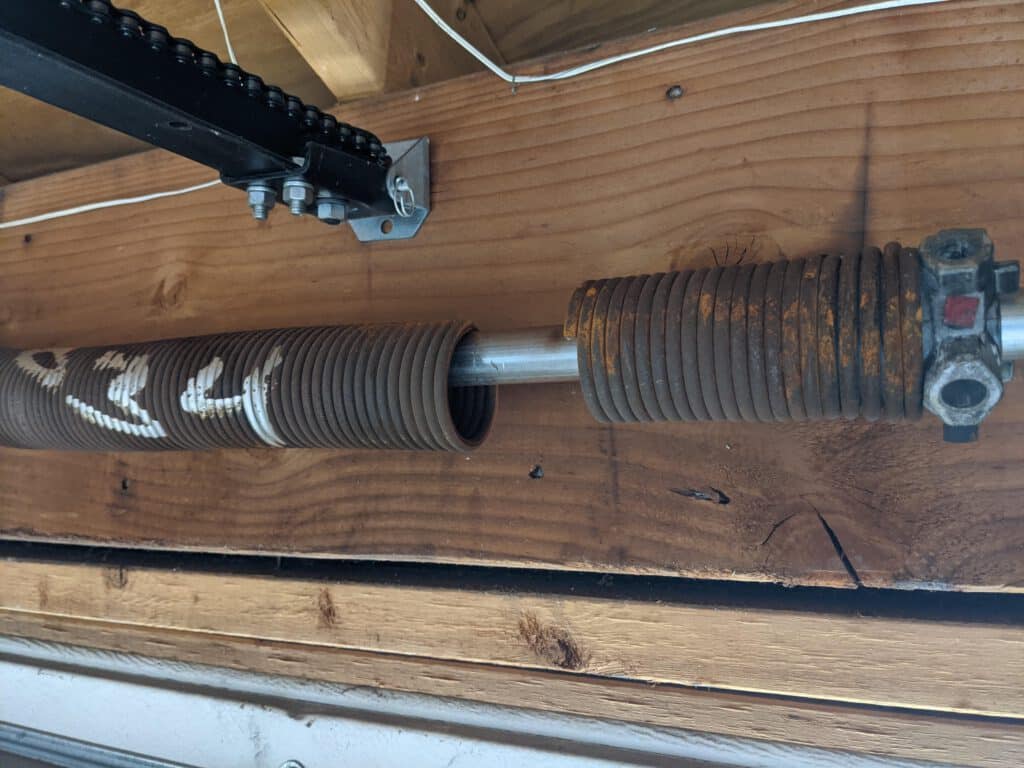If you’ve ever wondered, “How long do garage door springs last?” you’re not alone. Garage door springs are unsung heroes, quietly working behind the scenes to ensure the smooth operation of one of the most frequently used components of your home. We will explore the topic of garage door springs in this article and discuss their importance and lifetime.
Garage door springs might not be the first thing on your mind when you think about home maintenance, but they play a crucial role in the functionality and safety of your garage door. Without properly functioning springs, your garage door could become a liability rather than an asset. That’s why understanding their lifespan is essential for every homeowner.
Throughout this guide, we’ll provide you with valuable insights into the longevity of garage door springs. Whether you’re a new homeowner curious about maintenance schedules or a seasoned DIY enthusiast looking to extend the lifespan of your garage door system, we’ve got you covered. So, let’s embark on this journey together and unravel the mysteries surrounding garage door spring longevity.
Understanding Garage Door Springs

The Role of Garage Door Springs
Imagine your garage door as a massive slab of wood or metal, solid and unwieldy. Without springs, it would be an immovable obstacle, impossible to lift manually or with the assistance of a garage door opener. Garage door springs are the unsung heroes that make the seemingly effortless movement of your garage door possible. They counterbalance the weight of the door, applying force to either lift it open or lower it shut. Essentially, garage door springs act as the powerhouse behind the smooth operation of your garage door, allowing you to come and go with ease.
The Significance of Regular Maintenance
Just like any other mechanical component, garage door springs require regular attention and maintenance to ensure they continue to perform optimally. Regular maintenance not only prolongs the lifespan of the springs but also safeguards against unexpected failures that could leave you stranded inside or outside of your garage. Simple tasks like lubricating the springs, inspecting for signs of wear or damage, and ensuring proper tension can go a long way in preventing costly repairs and ensuring the safety of your garage door system. By incorporating maintenance into your home care routine, you can avoid the inconvenience and expense of sudden spring failure.
You might be wondering, what exactly determines the lifespan of garage door springs? It’s a question with multifaceted answers, each shedding light on different aspects of spring longevity. Factors such as the type of springs used, environmental conditions, and the quality of installation all come into play. Understanding these variables can provide valuable insight into how long your garage door springs are likely to last and what steps you can take to maximize their lifespan. So, let’s delve deeper into these factors and unravel the mysteries surrounding garage door spring longevity. Top of Form
Factors Affecting Lifespan
Types of Garage Door Springs and Their Durability
Extension springs and torsion springs are the two primary spring types used in garage door mechanisms. Utilizing torque to raise and lower the door, torsion springs are positioned horizontally above the garage door aperture. Many people have used these springs because of their reputation for strength and resilience. Alternatively, to allow for easier door movement, extension springs are positioned vertically on either side of the door and are capable of stretching and contracting. Despite being less expensive than torsion springs, extension springs typically last less time because of how they are made and positioned.
Environmental Factors: Temperature and Humidity
The environment in which your garage door operates can have a significant impact on the lifespan of its springs. Extreme temperatures, whether excessively hot or cold, can cause metal components to expand and contract, leading to stress and eventual fatigue. Similarly, high humidity levels can accelerate corrosion and rust formation, weakening the springs over time. To mitigate the effects of environmental factors, consider insulating your garage and investing in springs made from corrosion-resistant materials.
Frequency of Use and Quality of Installation
Another critical factor influencing the lifespan of garage door springs is the frequency of use and the quality of installation. Garage doors that are used frequently, such as those in households with multiple vehicles or high traffic, will naturally experience more wear and tear on their springs. Additionally, improperly installed springs or those that are not correctly calibrated to the weight of the door may wear out prematurely. To maximize the lifespan of your garage door springs, ensure they are installed by a qualified professional and consider investing in high-quality springs rated for your specific door weight and usage patterns.
By understanding and addressing these factors, you can prolong the lifespan of your garage door springs and maintain the safety and functionality of your garage door system for years to come.
Typical Lifespan Expectancy
General Estimate for Garage Door Spring Lifespan
Garage door springs, when properly maintained, typically have a lifespan ranging from 7 to 12 years. However, it’s important to note that this is a general estimate and can vary based on several factors, which we’ll explore shortly. Some well-maintained springs may even exceed this timeframe, while others may fail prematurely due to neglect or other factors.
Variability Based on Factors
The lifespan of garage door springs is far from one-size-fits-all. As mentioned earlier, factors such as the type of springs used, environmental conditions, frequency of use, and quality of installation all play significant roles in determining how long your springs will last. Torsion springs, for example, tend to have a longer lifespan than extension springs due to their design and placement. Likewise, springs installed in regions with extreme temperature fluctuations or high humidity levels may experience accelerated wear and deterioration.
Additionally, the frequency with which your garage door is used can impact spring’s lifespan. A door that sees frequent daily use will naturally experience more wear and tear on its springs compared to one that is used sparingly. Furthermore, the quality of installation is crucial. Springs that are improperly installed or not calibrated correctly to the weight of the door may fail prematurely, regardless of their inherent durability.
As we continue our exploration into the factors affecting garage door spring lifespan, I encourage you to stay tuned for further insights. Understanding these factors and how they interact can empower you to make informed decisions about maintaining and extending the lifespan of your garage door springs. So, let’s delve deeper into the intricacies of garage door spring longevity and uncover valuable tips for ensuring the continued smooth operation of your garage door system.
Signs of Wear and Tear
Common Indicators of Garage Door Spring Wear and Tear
It’s crucial to be vigilant for signs that your garage door springs may be reaching the end of their lifespan. Some common indicators include:
- Sagging or Uneven Garage Door: If you notice that your garage door is not opening or closing evenly, with one side appearing lower than the other, it could be a sign of worn-out or broken springs.
- Difficulty Opening or Closing: If your garage door feels unusually heavy to lift manually or is struggling to open or close smoothly with the assistance of the opener, worn-out springs may be to blame.
- Visible Wear and Tear: Inspect your garage door springs visually for any signs of damage, such as rust, corrosion, or gaps in the coils. These are clear indicators that the springs are nearing the end of their lifespan and may need to be replaced.
- Loud Noises During Operation: Excessive squeaking, grinding, or popping noises when operating your garage door can indicate that the springs are under strain and may be on the verge of failure.
Importance of Prompt Action to Avoid Accidents
Ignoring the signs of wear and tear on your garage door springs can have serious consequences. A sudden spring failure can lead to the door slamming shut unexpectedly, potentially causing damage to property or, worse, injuring you or your loved ones. By taking prompt action at the first sign of spring wear and tear, you can mitigate the risk of accidents and ensure the continued safety of your garage door system.
Are you unsure about what steps to take if your garage door springs show signs of wear and tear? Curious about the safety precautions you should follow when handling garage door spring replacement? Stay tuned for our upcoming Q&A section, where we’ll address these questions and more, providing you with valuable insights and guidance on maintaining the safety and functionality of your garage door system.

Frequently Asked Questions on How Long Do Garage Door Springs Last
How Can I Extend the Lifespan of My Garage Door Springs?
To extend the lifespan of your garage door springs, consider implementing the following maintenance practices:
- Regular Lubrication: Keep the springs lubricated with a silicone-based garage door lubricant to reduce friction and wear.
- Visual Inspections: Periodically inspect the springs for signs of wear, rust, or damage, and address any issues promptly.
- Balance Adjustment: Ensure that your garage door is properly balanced, as an unbalanced door can put extra strain on the springs.
- Professional Maintenance: Schedule regular maintenance with a professional garage door technician to identify and address any potential issues before they escalate.
What Should I Do If My Garage Door Springs Break?
If your garage door springs break, it’s crucial to take immediate action to prevent further damage or accidents. Follow these steps:
- Avoid Using the Door: Do not attempt to operate the garage door manually or with the opener, as it can cause further damage.
- Contact a Professional: Reach out to a reputable garage door repair company to assess the situation and replace the broken springs safely.
- Secure the Area: If the garage door is stuck in the open position, secure the area to prevent unauthorized access and ensure safety.
Can I Replace the Garage Door Springs Myself, or Should I Hire a Professional?
While it’s possible to replace garage door springs yourself, it’s highly recommended to hire a professional for several reasons:
- Safety: Garage door springs are under high tension and can be dangerous to handle without proper training and equipment.
- Expertise: A professional technician has the knowledge and experience to safely and correctly install new springs, ensuring optimal performance and longevity.
- Warranty: Many garage door manufacturers require professional installation to maintain warranty coverage.
Are There Any Safety Precautions I Should Take with Garage Door Springs?
Absolutely. When dealing with garage door springs, safety should always be a top priority. Here are some essential precautions to keep in mind:
- Wear Protective Gear: Wear safety glasses and gloves to protect your eyes and hands from potential injuries.
- Use Proper Tools: Use the appropriate tools and equipment for the job, and never attempt to improvise or use makeshift tools.
- Release Tension Safely: If you need to release tension from the springs, follow the manufacturer’s instructions carefully and use the proper tools to prevent accidents.
Is It Possible to Upgrade to Longer-Lasting Garage Door Springs?
Yes, it is possible to upgrade to longer-lasting garage door springs, such as high-cycle or galvanized springs. These springs are designed to withstand more cycles of opening and closing, providing extended durability and lifespan. Consult with a professional garage door technician to determine the best spring upgrade options for your specific needs and budget.

Conclusion
In conclusion, understanding the lifespan of garage door springs is essential for every homeowner. We’ve explored the crucial role these springs play in the functionality of your garage door, highlighted the significance of regular maintenance, and discussed factors that can affect their lifespan. From the types of springs used to environmental conditions and frequency of use, there are several variables to consider when assessing the longevity of your garage door springs.
Regular maintenance and prompt action are key to ensuring the continued safety and functionality of your garage door system. By staying vigilant for signs of wear and tear, addressing issues promptly, and scheduling routine maintenance with a professional technician, you can extend the lifespan of your garage door springs and prevent costly repairs or accidents.
For more insights and answers to your questions about garage door maintenance, safety, and upgrades, continue exploring our resources. Whether you’re a seasoned DIY enthusiast or seeking professional guidance, we’re here to provide you with the knowledge and support you need to keep your garage door system in top condition. Remember, a well-maintained garage door is not just a convenience—it’s a crucial aspect of home safety and security.



